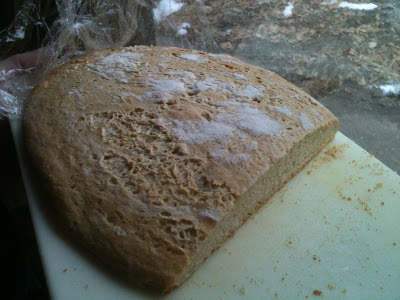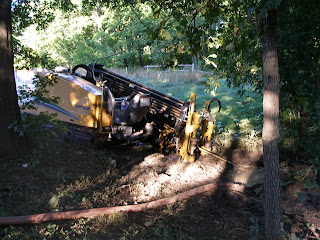The Power of Soil
An on-the-road excerpt from The Soil Emergency, Famine in the Horizon.
So what am I holding in my hand here? This is soil. It's not dirt that's what we get out of our vacuum cleaner. This is soil, this is a mass of living and breathing organisms. It's not just nitrogen, phosphorus, potassium, calcium. It's also partially arsenic and lead as a matter of fact, many minerals in varying amounts. It's also not just a mixture of sand silt and clay. This soil in my hand is a living and breathing ecosystem. Now we think that we are powerful and a major player in Earth's life systems, the soil is responsible for cycling the nutrients for all living organisms on the Erath, outside of the ocean.
This organic and living ecosystem is responsible for converting all organic material from the flora and fauna above and below the soil surface into the soluble compounds that plants need and animals eat. The soil breaks down the dead tissues and bones and stems and leaves so that they can then again be taken up by the next generation of living organisms. Nutrient cycling that sustains generations of plants and animals begins in the soil and ends in the soil. It is these organisms in the soil that feed the plants, from mycellium, to fungi, bacteria, each breaks down the organic compounds to the components usable and absorb-able by the roots of plants.
Hundreds of millions of these ecological partners live in a handful of soil. It is this soil that we need to keep alive and healthy in order to sustain ourselves and the ecosystems we depend on. When we are gardening or managing an orchard, we are as much as managing the health of the soil as if it was our own health. Our harvests, our nutrition from the crops that we harvest is dependent upon the health of our soil. That is the mindset that we must have to sustain ourselves. We must farm the soil as the basis for all of our other crops.
Ranchers using rotational grazing know that growing healthy grasses and forbs, so that a pasture is rich in nutrients is the key to healthy livestock. Many of them consider themselves grass farmers. And how do they get healthy grass? By managing the nutrient cycling of their livestock and increasing the richness of their soil, for it is the soil that supplies rich pastures. They allow the soil to rest and increase its fertility naturally. Large livestock is followed by chickens and a time for the trophic levels of soil organisms to cycle their manure to the plants. This creates healthy soil ecology which supplies the minerals and nutrients to the roots of plants.
The soil beneath our feet is living and breathing. All the organisms and even the plant roots have respiration. The exchange of gases between the atmosphere and the soil horizons is performed by the organisms themselves. In a healthy soil, a complete gas exchange from soil to atmosphere as deep as 2 feet is completed within as little as 6 hours. This is why compaction and over-watering in our cropping areas is so detrimental to soil health. The plants not only need access and good drainage of water but also the ability to obtain oxygen and atmospheric nitrogen.
Another way that we can ensure the soil health in our growing systems is to return nutrients that have been taken back to the soil when we are through with them. A large portion if not most of the organic material removed from a garden as produce is wasted during the cleaning and processing. Additional amounts are wasted during the cooking process, before you can even reach our plate. It is important that all of this material we returned to the garden. These ecologically expensive nutrients and minerals which are instantly available the soil organisms will aid us in keeping our soil rich and fertile. Extracting these minerals and nutrients from the soil depletes it and reduces the following yields.
All native plants are in a natural capital partnership with the local soil, they have to be. Plants are either building from the soil or becoming part of the soil. A tree that does not survive becomes soil, a plant that does not survive becomes soil. All organic material comes from the soil. A plant must fit the niche in which it germinates in order to thrive. Plants that are aligned with the soil conditions will prosper and increase the soils ability to support other plants. Each soil type and condition has a cadre of plants which are suitable. Over time these plants will change as they are added to the organic material in the soil and change the soils conditions.
The soil conditions will only allow certain plants to establish. Each soil type and the environmental condition limits the candidates. There is a succession of deep and fibrous plant roots which create spaces for soil respiration. Layers of detritus or dead plant material create a covering of soft decomposing organic matter that also cools and retains moisture in the soil below. This natural process increases the soil organism populations, large and small. It creates opportunity for diverse plant groups to establish themselves and build a resilient ecosystem.
In nature soil health is allowed to happen naturally, with only limited disturbance. This model for soil building is important to follow while building a highly productive agricultural ecosystem. Repeated disturbances through plowing and access compaction reduces the soils ability to create and retain fertility.
Even though we cannot see the organisms underground we can create a suitable environment for them by limiting our disturbances to the soil.
- We can continually add compost throughout the season.
- We can add organic material such as green manures and use mulch.
- We can keep the soil covered with soil building crops during the off-seasons.
- We can rotate our garden plots and fields creating beneficial habitat for beneficial insects.
- We can inter-crop and use companion plants that will share the soil resource.
- We can reduce and limit our plowing and tilling.
- Finally we can limit watering to an appropriate amount that is suitable to the soils conditions. By this we can increase soil health and increase soil depth that will retain moisture during dry periods and hold nutrients for our crops.


Comments